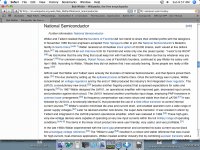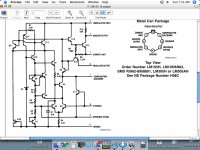I do not want to enter a discussion about the audibility of the 7th harmonic, but just
wanted to show that in real circuits (as opposed to datasheets with measurements at
unity gain) it´s obviously there.
Actually, the datasheets in question don't show the devices at unity gain. Nor, contra John's false assertion, is this a phenomenon peculiar to ICs- some show it in some circuits, some don't, just like discrete.
If 7th and 9th are what separate "high end" from "mid fi," it's clear that good IC circuits are "high end." It's just not the particular fashion that John is selling.
...
If 7th and 9th are what separate "high end" from "mid fi," it's clear that good IC circuits are "high end." ...
Well the OP227, OPA2604, AD8620 etc. would not qualify then.
It's the reference that is really quiet - about 7uV IIRC. And, you can decouple it easily so it really is low noise. The LM3xx are about 30uV/V of output, to a 15V output has nearly half a mV of noise.
As Ed says who knows what's happened to the 723 process(es) now. The TI databook of 1996 shows a 5V output configuration as having 20uV of output noise 100Hz-10kHz with no lowpass filtering of the reference voltage of 7.15V, dropping to 2.5uV with 5uF bypassing the reference divider equivalent resistance of 10k. That's pretty decent. As this is certainly including some of the 1/f corner noise, and there is input diff amp current noise, that's still reasonably consistent with 7uV of mostly midband for the raw reference.
I should pull one out of ancient parts stock and measure it. I think I still have a couple in metal cans.
What separate "high end" from "mid fi" rely on a very measurable measurement data: Price.
While i'm not able to hear any obvious difference in my system between my preamp (Ic based) and a short wire, i do not ask myself questions about any evils.
Of course, this have only a very subjective value, as i'm unwashed with poor hearing ability, comparing to John's one, if we believe in what he pretend.
In a way, it can be correlated with his aversion to CDs, while i enjoy a lot of them.
As well as my strange ability to suffer evil compression drivers and horns.
Sure he is able to hear things that i do not.
I strongly recommend to everybody to try to be as deaf as i am, as it save a lot of money and brings so much pleasure, listening to good music, not available on an other support than CDs. on a system you are not obliged to change all the weeks.
Oh, one good thing about ICs is you can try in a snap the ones which make no differences, and no need to make any measurements.
While i'm not able to hear any obvious difference in my system between my preamp (Ic based) and a short wire, i do not ask myself questions about any evils.
Of course, this have only a very subjective value, as i'm unwashed with poor hearing ability, comparing to John's one, if we believe in what he pretend.
In a way, it can be correlated with his aversion to CDs, while i enjoy a lot of them.
As well as my strange ability to suffer evil compression drivers and horns.
Sure he is able to hear things that i do not.
I strongly recommend to everybody to try to be as deaf as i am, as it save a lot of money and brings so much pleasure, listening to good music, not available on an other support than CDs. on a system you are not obliged to change all the weeks.
Oh, one good thing about ICs is you can try in a snap the ones which make no differences, and no need to make any measurements.
First part of a good article on contacts:
Jonn,
Could you, please, post the second part of this Antler's paper? I'd love to read it to the end. Thanks!
P.S. For those that are interested in this topic, here's another paper by the same author that I was able to dig up.
Attachments
That depends on circuit, load, and level, no? I have no personal experience with those, so am agnostic. Likewise, there's no published spectra of the BT, so I have no idea if it's "high end" or not by that definition.
I do, I have my own measurements of dozens of opamps under normal conditions, with standard load like 2k - 10k, 2Vrms, gain 1 - 10. None of the good opamps (OPA627, AD797, OPA134 ...) has any residual 7th above -120dB. They do not sound same, but the 7th is not the reason. John's fairy tales about the 7th are marketing claims. We can easily find the 7th above -120dB in many so called High End products, as I have linked earlier.
Witch one you had listened to, between all OPAs you tested was the closer to a strait wire ?They do not sound same,
This is a difficult question, for the reason that line preamp may sound better than the straight wire. IMO the reason is that if you filter HF from digital sources (I mean spikes and D/A residuals) the preamp may sound better.
My favorite opamp is AD844 - for line level.
My favorite opamp is AD844 - for line level.
Last edited:
Throw-it away immediately !This is a difficult question, for the reason that line preamp may sound better than the straight wire.
(Or sold-it as a recording studio gear
You are a cheater, choosing a high slew-rate current feedback device
I am searching right now a voltage feedback double opa for DACs (voltage, differential) and i do not find anything fast and quiet enough on the paper.
Last edited:
Thanks for putting up the complete article, Electroj, but I do not know if I have the second part. It all depends on old issues of IEEE papers.
The study of contacts is an old field of research. The telephone business and power industries used millions of relays all across the country and cities...switch gear... contacts of all sorts had to be reliable and so contacts were heavily studied and materials developed for all manner of contacts from telephones to power switching.
One of the early 'bibles' to find is "Electric Contacts" by Ragnar Holm. My edition is 4th (1967) is published by Springer-Verlag. I added it to my technical library in 1981. You can branch out from here by using its author and literature index. Everything you ever wanted to know and a lot more can be found within this contacts Bible. (ISBN 3-540-03875-2 and 0-387-03875-2)
Thx-RNMarsh
Last edited:
Thanks again, Electroj, for putting up the article that you put up here. I first misunderstood what you wanted from me. What you want is the rest of the article, rather than a second part to the article. I will dig around, it is here, someplace, but I have to individually scan it, so it might take some time.
Richard is right. Holm is the best reference, I have one of Holm's books, as well. Mine is called 'Electronic Contacts Handbook' from 1958. Either book is a real 'bible' for contacts, but quality engineering articles from Whitley (sp) from AMP, will give you even more easily understandable info on contacts.
Richard is right. Holm is the best reference, I have one of Holm's books, as well. Mine is called 'Electronic Contacts Handbook' from 1958. Either book is a real 'bible' for contacts, but quality engineering articles from Whitley (sp) from AMP, will give you even more easily understandable info on contacts.
- Status
- Not open for further replies.
- Home
- Member Areas
- The Lounge
- John Curl's Blowtorch preamplifier part II

